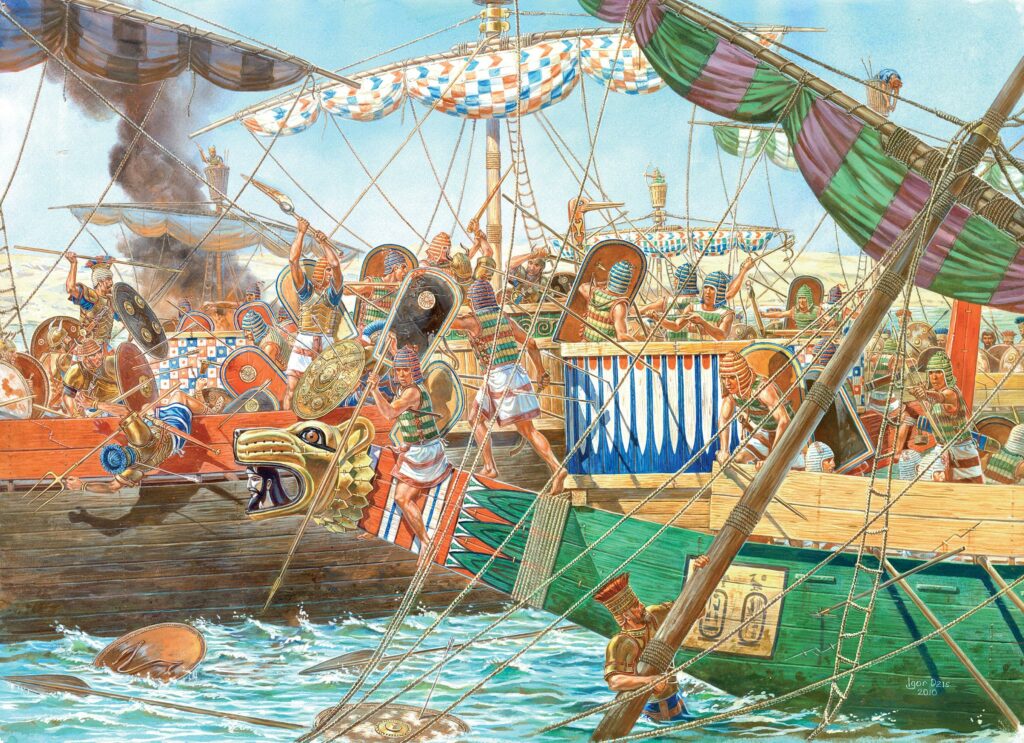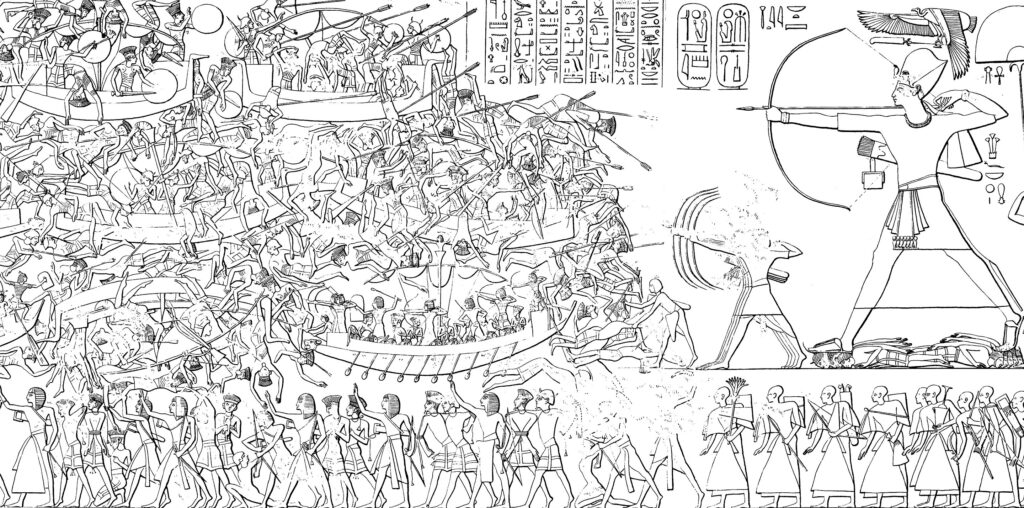The Sea People, as ordinary as the name may sound now, were terrifying some centuries ago, especially to the ancient world kingdoms who witnessed their rampage.
History only referred to them as The Sea Peoples when the French Egyptologist Gaston Maspero coined it in 1881. Maspero coined the phrase because historical accounts claimed that these tribes sprang “from the sea” or “the islands,” but they never specified which sea or which islands, leaving the origin of the Sea Peoples a mystery.
The Sea Peoples were a group of ancient maritime raiders believed to have caused widespread destruction and disruption in the eastern Mediterranean region during the late Bronze Age, between approximately the 13th and 11th centuries BC.
The Sea Peoples have been mentioned in the texts of several ancient civilizations, including the Egyptians, the Hittites, and the Assyrians, who all recorded their attacks on various parts of their empires.
It is thought that the Sea Peoples were a confederation of different groups, possibly including the Shardana, the Peleset, and the Tjekker, who were known for their naval skills and their use of chariots in battle.

The motivation behind The Sea Peoples’ rampage
The exact origins and motivations of the Sea Peoples are not well understood and remain a mystery to historians. Likewise, their reason for leaving their homes and searching for another land to invade is unclear to scholars.
Some scholars believe that they may have been driven to raid and pillage by economic or environmental factors, such as drought, famine, or overpopulation.
Others speculate that they may have been motivated by political or ideological factors, such as war, a desire to gain power, or to spread their culture.
The Sea Peoples’ origin
The origin and history of the Sea Peoples would be totally concealed from history if not for a little mention about them from the people they fought.
Unlike other ancient tribes and people, the Sea Peoples didn’t leave behind any monuments or documentation of their lives, and we have no idea if it was on purpose. Instead, everything historians know about the Sea Peoples comes from apocalyptic inscriptions made by the empires that had previously battled with them, particularly the Ancient Egyptians.
According to some contemporary historians, the manner the Egyptians wrote about the Sea Peoples suggests that they were aware of their origins.
The fact that these inscriptions make no mention of the group’s beginnings has led some people to conclude that this information was well-known enough that it wouldn’t need to be expressed. The Sea Peoples needed no introduction!
The Sea Peoples’ threat to the ancient civilization – the Bronze age
Over 3000 years ago, a thriving and integrated Bronze Age civilization supported by profitable trade in valuable metals and finished items occupied the Mediterranean and the Near East.
The great kingdoms and empires of the time, such as the Egyptians, Babylonians, Minoans, Mycenaeans, Hittites, and others, have the technological prowess to construct colossal palaces and employed scribes to keep accounts of their finances and military accomplishments.
But within a few decades, that thriving civilization experienced a quick and almost complete collapse. The survivors of this Bronze Age collapse were thrust into the “Dark Ages” after 1177 BC, which lasted for several centuries and saw the extinction of several recorded languages and the downfall of once-powerful kingdoms.
The ‘Sea Peoples’ invasion
The arrival of pillaging invaders, known collectively as the Sea Peoples, around the turn of the 12th century BC is the classic explanation for the rapid collapse of these mighty and interdependent civilizations.
The king of Ugarit wrote of unidentified adversaries who destroyed his cities and carried out heinous, awful deeds in his nation, a significant port city in Canaan.
The pharaoh’s forces repelled numerous raids from these unidentified outsiders through the reigns of three successive pharaohs in Egypt—Ramesses II, Meremptah, and Ramesses III. On the walls of Ramses III’s temple at Medinet Habu, a magnificent relief shows the second significant sea battle, in which Egypt eventually triumphed over the horde of Sea Peoples.
The battle between Ramesses II and the Sea Peoples of the Bronze Age
From 1279 until 1213 BC, Ramesses II, also known as Ramesses the Great, governed Egypt. During his reign, Ramesses II came into contact with the Sea Peoples while battling the Hittites.
He paid for inscriptions that describe his victory over the Hittites in 1274 BC and portray the Sea Peoples as working with Egypt’s adversary. He also talks about ambushing the Sea Peoples at the Nile’s mouth.

Between Merenptah and The Sea Peoples
Ramesses II’s texts show that the Sea Peoples were finally defeated, but his son and heir, Merenptah (or Merneptah), encountered them throughout his reign (1213 BC –1203 BC). He depicts a coalition of the Sea Peoples and the Libyans assaulting the Nile Delta in 1209 BC.
The statement that they came from the north is one of the hints that historians have deduced from this tale. Even though it’s not apparent where Teresh, Ekwesh, Lukka, or Sherden are, he identifies them nonetheless.
Merenptah, like his father before him, had inscriptions engraved commemorating his triumph against the Lybians and Sea Peoples.
Sea Peoples and Ramesses III
By the time Ramesses III fought the Sea Peoples in his second year in office, the Hittites had already been overthrown, according to Ramesses III, around 1200 BC.
When the Sea Peoples assaulted an Egyptian commercial post at Kadesh in 1180 BC, it was in his time. He defeated them there as his predecessors had, but the post was demolished. Additionally, he would confront them once more if they attacked Egypt itself.
The Sea Peoples were defeated near the city of Xois in 1178 BC and were never heard from again. The battles that would follow would take place on both land and water. However, this came at a cost because it emptied the Royal Treasury.
Other civilizations weren’t as successful in repelling the Sea Peoples as the Egyptians were. Cities destroyed during this time, such as Meggido in Canaan and Hattusa, the former capital of the Hittite Empire, are littered throughout the Mediterranean and Near East. Some argue that the invasion of the Sea Peoples may have served as the catalyst for the legendary destruction of Troy.
The End of the Sea Peoples
Despite their fearsome reputation, the Sea People swere eventually defeated by the combined forces of the ancient civilizations they had attacked.
The Egyptians, in particular, were able to repel the Sea Peoples and drive them back, thanks in part to their navy’s strength and their commanders’ skill.
The legacy of the Sea Peoples lives on today in the historical and archaeological record, as well as in the mythology and folklore of the cultures they encountered.
They are remembered as a mysterious and formidable group of ancient warriors whose raids and battles shaped the course of history in the eastern Mediterranean region.


Some commentators have alluded to the Philistines as the mysterious Sea People.
You forgot the Phillistines, who invaded Canaan and settled for several centuries in the south of what became Israel. The Peleset, or plishtim (invaders, in Hebrew) were part of the Sea People. Archaeology in their ancient towns revealed, through DNA, that they originated from north eastern Mediterranean. (And no, the Arabs who invaded Israel in the 7th century are NOT Phillistines nor Palestinians.